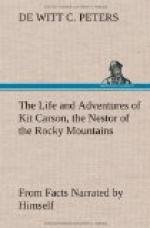The command of these forty Mexicans and Pueblo Indians was conferred upon James H. Quinn, a well-known and prominent citizen of New Mexico. This gentleman became intimately associated with the Territory of New Mexico soon after that country was annexed to the United States. In politics, military life, farming and mercantile pursuits, he was most actively engaged, and by his talents and industry took a prominent position and became an influential member of society. He had some faults; (who has not?) but his unexpected death came so suddenly upon his friends that they could only think of him for the many good qualities both of his head and heart. Hence, his faults were most willingly passed over in silence.
All things being in readiness, the command entered upon the pursuit of the Indians. They marched from Taos, ten miles north, to a stream called the Arroya Hondo. Thence, following the banks of this stream down through its deep and rocky canon, they came to the Rio del Norte.
On the first-named stream, there is a small and unattractive settlement, which bears the same name. Several years since, there was a large distillery in full operation at this place. This establishment was owned by an American, and was very extensive. The building was celebrated as being the place where several Americans were slaughtered by the Mexicans during the revolution, in which Governor Bent lost his life, heretofore spoken of. On the plain which is contiguous with the south bank of the Arroya Hondo, there are to be found the remains of a large Aztec town, which was, at some remote period, the largest settlement inhabited by that interesting people to be found in northern New Mexico. At the present day, can be seen the size and almost the number of houses which formed the town—which are very numerous. The building material, as here used




